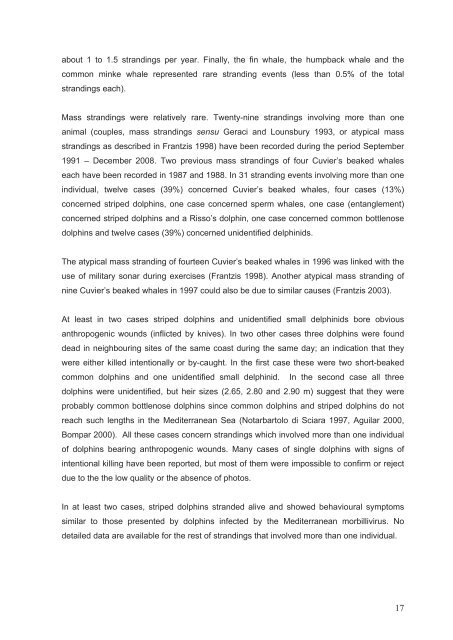Cetaceans in Greece: Present status of knowledge
Cetaceans in Greece: Present status of knowledge
Cetaceans in Greece: Present status of knowledge
You also want an ePaper? Increase the reach of your titles
YUMPU automatically turns print PDFs into web optimized ePapers that Google loves.
about 1 to 1.5 strand<strong>in</strong>gs per year. F<strong>in</strong>ally, the f<strong>in</strong> whale, the humpback whale and the<br />
common m<strong>in</strong>ke whale represented rare strand<strong>in</strong>g events (less than 0.5% <strong>of</strong> the total<br />
strand<strong>in</strong>gs each).<br />
Mass strand<strong>in</strong>gs were relatively rare. Twenty-n<strong>in</strong>e strand<strong>in</strong>gs <strong>in</strong>volv<strong>in</strong>g more than one<br />
animal (couples, mass strand<strong>in</strong>gs sensu Geraci and Lounsbury 1993, or atypical mass<br />
strand<strong>in</strong>gs as described <strong>in</strong> Frantzis 1998) have been recorded dur<strong>in</strong>g the period September<br />
1991 – December 2008. Two previous mass strand<strong>in</strong>gs <strong>of</strong> four Cuvier’s beaked whales<br />
each have been recorded <strong>in</strong> 1987 and 1988. In 31 strand<strong>in</strong>g events <strong>in</strong>volv<strong>in</strong>g more than one<br />
<strong>in</strong>dividual, twelve cases (39%) concerned Cuvier’s beaked whales, four cases (13%)<br />
concerned striped dolph<strong>in</strong>s, one case concerned sperm whales, one case (entanglement)<br />
concerned striped dolph<strong>in</strong>s and a Risso’s dolph<strong>in</strong>, one case concerned common bottlenose<br />
dolph<strong>in</strong>s and twelve cases (39%) concerned unidentified delph<strong>in</strong>ids.<br />
The atypical mass strand<strong>in</strong>g <strong>of</strong> fourteen Cuvier’s beaked whales <strong>in</strong> 1996 was l<strong>in</strong>ked with the<br />
use <strong>of</strong> military sonar dur<strong>in</strong>g exercises (Frantzis 1998). Another atypical mass strand<strong>in</strong>g <strong>of</strong><br />
n<strong>in</strong>e Cuvier’s beaked whales <strong>in</strong> 1997 could also be due to similar causes (Frantzis 2003).<br />
At least <strong>in</strong> two cases striped dolph<strong>in</strong>s and unidentified small delph<strong>in</strong>ids bore obvious<br />
anthropogenic wounds (<strong>in</strong>flicted by knives). In two other cases three dolph<strong>in</strong>s were found<br />
dead <strong>in</strong> neighbour<strong>in</strong>g sites <strong>of</strong> the same coast dur<strong>in</strong>g the same day; an <strong>in</strong>dication that they<br />
were either killed <strong>in</strong>tentionally or by-caught. In the first case these were two short-beaked<br />
common dolph<strong>in</strong>s and one unidentified small delph<strong>in</strong>id. In the second case all three<br />
dolph<strong>in</strong>s were unidentified, but heir sizes (2.65, 2.80 and 2.90 m) suggest that they were<br />
probably common bottlenose dolph<strong>in</strong>s s<strong>in</strong>ce common dolph<strong>in</strong>s and striped dolph<strong>in</strong>s do not<br />
reach such lengths <strong>in</strong> the Mediterranean Sea (Notarbartolo di Sciara 1997, Aguilar 2000,<br />
Bompar 2000). All these cases concern strand<strong>in</strong>gs which <strong>in</strong>volved more than one <strong>in</strong>dividual<br />
<strong>of</strong> dolph<strong>in</strong>s bear<strong>in</strong>g anthropogenic wounds. Many cases <strong>of</strong> s<strong>in</strong>gle dolph<strong>in</strong>s with signs <strong>of</strong><br />
<strong>in</strong>tentional kill<strong>in</strong>g have been reported, but most <strong>of</strong> them were impossible to confirm or reject<br />
due to the the low quality or the absence <strong>of</strong> photos.<br />
In at least two cases, striped dolph<strong>in</strong>s stranded alive and showed behavioural symptoms<br />
similar to those presented by dolph<strong>in</strong>s <strong>in</strong>fected by the Mediterranean morbillivirus. No<br />
detailed data are available for the rest <strong>of</strong> strand<strong>in</strong>gs that <strong>in</strong>volved more than one <strong>in</strong>dividual.<br />
17


